Mahindra XUV700: platform
If you were perplexed with the XUV700's naming, you wouldn’t be the only one. After all, the car – codename W601 – was to be the new XUV500. It followed the same template – a transverse engine layout, monocoque body and designed with three rows of seats.
There was also nothing wrong with the XUV500 moniker either. Yes, sales have fallen in the decade since its launch, but the name still has good brand value. But seeing just how much of an improvement the W601 was over its predecessor, Mahindra felt it was good enough to be a segment higher. Hence, keeping with the alpha-numeric naming hierarchy, they called it the XUV700. This naming strategy achieved two things; first, it has given the XUV700 a more premium position and second, it has left space below for another product to be badged the XUV500.
Underpinning the XUV700 is a brand-new platform, and the company says the new monocoque is 80 percent stiffer than the XUV500’s, thanks to an increase in the number of spot welds and adhesive bonding.
Mahindra has worked hard to reduce weight, with the XUV700’s monocoque frame using quite a bit of lightweight high-tensile steel and other weight-saving measures like lighter engines, which weigh around 70kg less than before. Overall kerb weight ranges from 1,960kg-2,040kg, which is still heavy but it takes into account the additional equipment and safety features the XUV700 is loaded with. Interestingly, the rear tailgate is made of composite plastic that's aimed at weight reduction. However, this could pose a practical problem because, unlike sheet metal, which can be easily repaired if damaged in an accident, the plastic tailgate may need to be replaced if you are rear-ended.
Like with the XUV500, the platform is configured for front-wheel-drive and all-wheel-drive options. Although this time round, it is designed to accommodate a 48V mild-hybrid system as well, which could come in the future.
The engine line-up includes a pair of brand-new engines – the latest-gen 2.2-litre mHawk diesel and mStallion 2.0 turbo-petrol – both of which debuted in the Thar. However, power figures have been hiked significantly in the XUV700. The base diesel variants get a 155hp rated motor but this output jumps to a class-leading 185hp for higher variants. Taking the power stakes to a different level is the 2.0 turbo-petrol that, armed with variable valve timing, direct-injection and turbo power, produces a class-busting 200hp.
The new platform also makes use of the latest-generation electrical and electronics (E/E) architecture, enabling it to host an advanced infotainment system (from Visteon) and a suite of advanced driver assistance systems (ADAS) never seen in a car in this class or price. Mahindra is clearly determined to ‘out-tech’ the competition.
Mahindra XUV700: style
The XUV700’s styling is a mature evolution of the XUV500, with cleaner lines and a more balanced look. It sits lower than its predecessor (by 30mm), comes with a muscular bonnet, and a strong new grille with twin vertical bars, which gives it a lot of road presence. A nice touch is the way the outside vertical bars bend and flow into the headlight cluster. Making its debut on the XUV700 and sitting proudly in the centre of the grille is Mahindra’s new ‘Twin Peaks’ logo, which interestingly will only adorn the automaker's SUV range.
The profile is perhaps the cleanest side of the new car, gone are the numerous rear wheel arch lines and the odd cheetah paw handles, in their place are flush door handles that pop automatically when you approach the car; very cool and handy to use too, though mid versions require you to push the handle to pop it while the base variant will have a little cumbersome click to unlock (key), push to pop and then pull to open action.
At the rear, the arrow-shape tail-lights are striking but the design feels like it belongs to another car; it is an example of the lack of consistency and cohesiveness in the styling, which still has too many fussy elements like the disproportionately long DRLs and the excessive sculpting of the wheel arches that dwarf the 18-inch wheels.
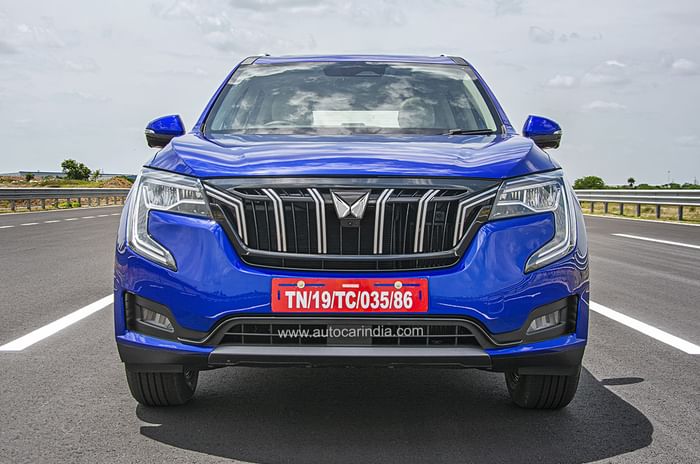
The design, though not as refined as the competition, has the required details for those looking for some flash.
Mahindra XUV700: interior
The interior design is more straightforward and taking centre stage is a display panel that stretches across half the dashboard. This Mercedes-like tablet houses a central touchscreen and an all-digital instrument panel, both measuring 10.25 inches. It looks very premium and will be a big hit with consumers; best of all, it is offered on all versions except the base, which will get a smaller 8.0-inch infotainment unit and a 7.0-inch instrument cluster.
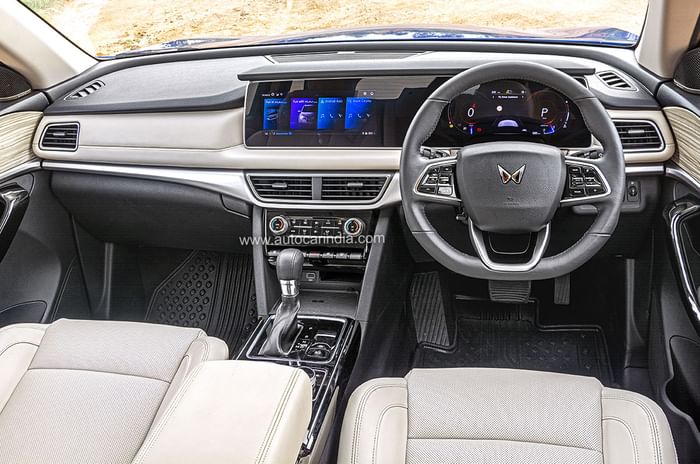
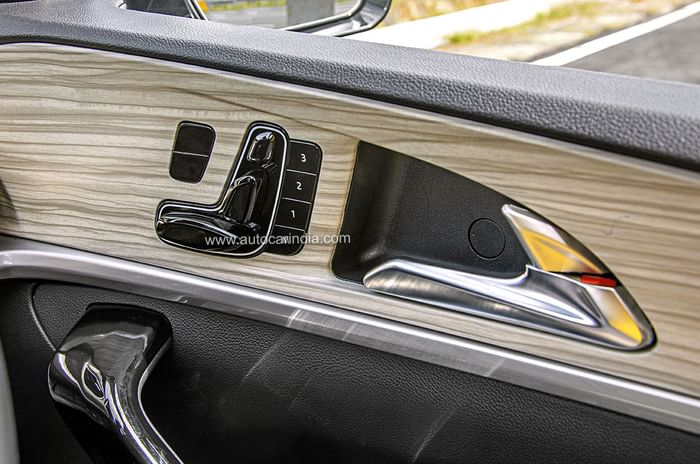
Mahindra has mercifully retained buttons and dials for HVAC controls, and while the cluster is a carry-forward from the 500, it’s still welcome. The rotary controller on the centre console means you don’t have to use the screen for everything and there’s also a neat-looking bank of toggle-like switches for some key functions.
A real clever touch are the two shelves in the central consoles for two phones, one of which is a wireless charger. In today’s smartphone era, convenient storage for two phones is perhaps more important than cupholders, which are also present on the console behind the gear lever.
Mahindra XUV700: features
The steering wheel feels nice to hold and the buttons, though not slick to operate, give access to a lot of functions. The jazzy instrument panel has cheerful colour schemes and perhaps more sober graphics and fonts would been in order, but the information is incredibly rich and there are many customisable options for both screens.
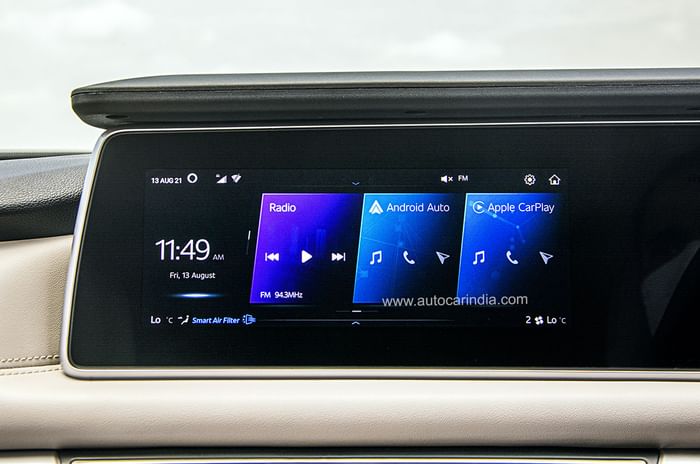
The XUV700 also debuts Mahindra’s new AdrenoX infomatics system, which is the most advanced and feature-packed infotainment system in not just its class but also in several classes higher. It is crammed with features and options, and even has some built-in local apps like JustDial and Zomato.
However, there is a problem of plenty; the segregation and layering of the menu needs a lot of work and it’s not really intuitive and easy to find out where things are. You end up toggling with the switches and fumbling with the menu and sub-menus, which doesn’t bring you back to the same function when you leave it. The infotainment operation though is still in beta stage, so we’ll reserve comment on how slick it is and how well it functions when the system is finally ready in time for the launch.
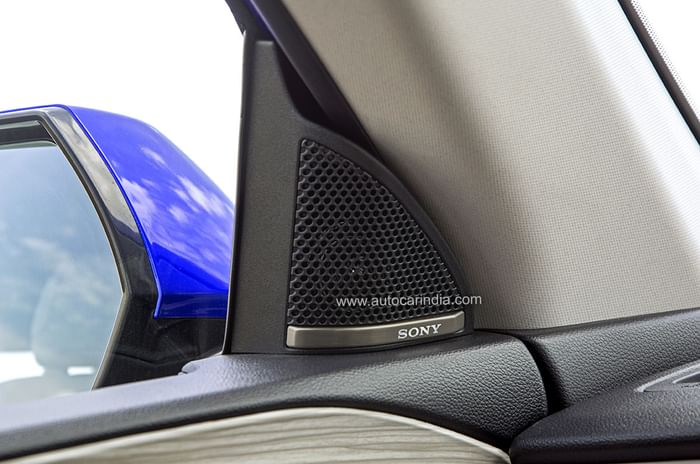
The XUV700 also signals Mahindra’s entry into the premium sound arena, with a superb Sony 3D audio system that uses a 13-channel amplifier powering one subwoofer and 12 speakers: including four in the roof. Then there’s Alexa voice assistant, and the XUV700 is the first car to come embedded with it, which makes a separate connected device not mandatory. Alexa is also integrated into the full connected car experience, so you can also ask for alerts and updates about your car right from your home.
Other interesting bits include a powered driver seat with door-mounted switches (inspired by Mercedes), dual zone climate control with an air-purifier system, and connectivity options that include Apple CarPlay and Android Auto.
Mahindra XUV700: seating and comfort
The seats are large and generous, especially up front, and the cushioning, though a touch on the firm side, offers good all-round support, keeping you free from aches even after long hours in the cabin. The XUV700 comes in 5- and 7-seat configurations, but it’s the three-row version we were testing. While the legroom in the middle row may not be as generous as the Hector or Safari, there is ample space and even tall passengers will be comfy, despite the massive panoramic sunroof's thick frame eating a bit into the headroom. Despite the 50mm increase in wheelbase over the XUV500, third-row room isn’t that much, and headroom too is very limited here. There are, however, dedicated AC vents and the glass area is quite large.
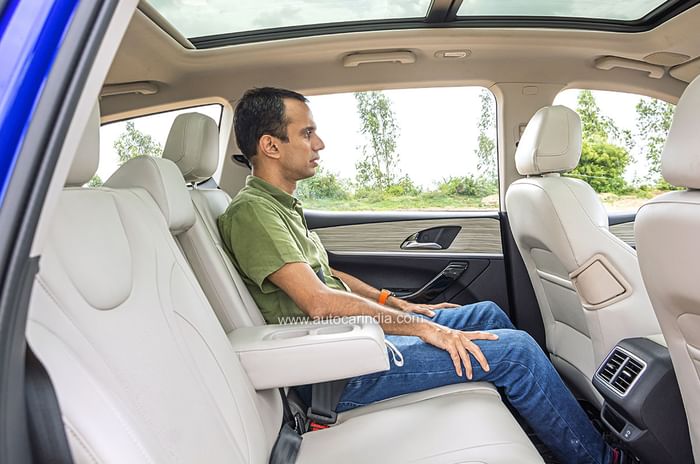
Ergonomics have been a bit of a hit and miss for Mahindra. While the XUV700 has addressed most points, there are a few issues: the gear lever and rotary controller feel a little too rear-set, as do the power window switches. The third-row reclining mechanism should also have been at the top of the seat rather than behind, as you have to twist around and reach over to pull the handle for adjusting your own seat. With the third row up, boot space is limited, but there’s ample luggage room with the third row folded down. Shifting the spare wheel’s location from under the boot floor to under the chassis has also freed up more room, but we are not sure how convenient this arrangement is when it comes to changing a flat.
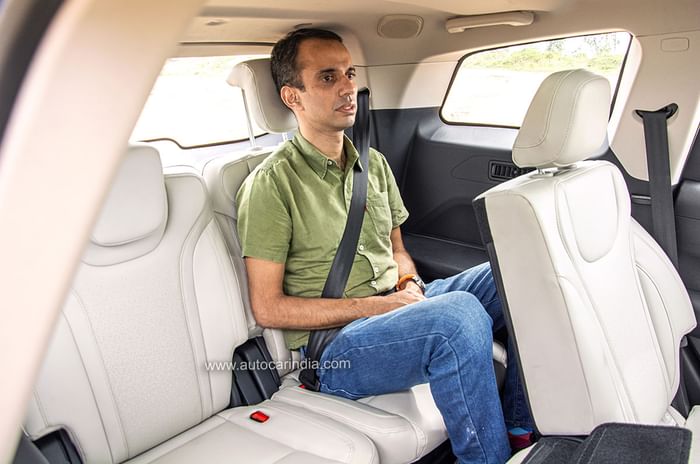
Mahindra XUV700: engines
The petrol and diesel engines on offer get both, the 6-speed manual and automatic gearbox options. While the XUV500’s 155hp diesel carries on only in the base version, higher variants get a more powerful version of the 2.2-litre mHawk unit that cranks out 185hp. This makes the XU700 diesel the most powerful in its class, ahead of the Hyundai Alcazar, with its 115hp, 1.5-litre diesel, and also the Hector Plus and the Safari, which use the same 170hp 2.0-litre Fiat-sourced diesel engine.
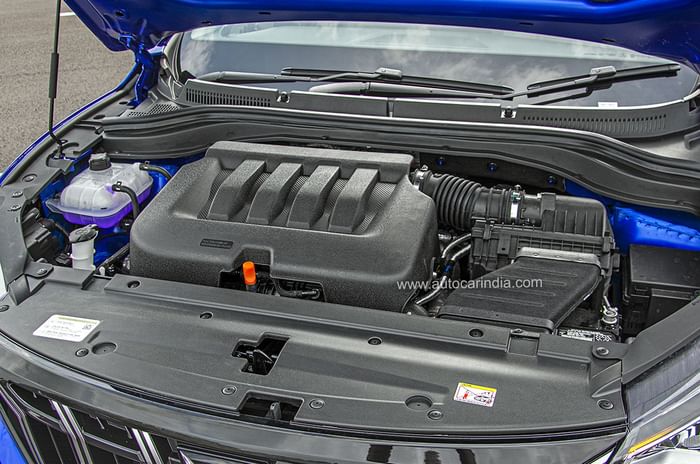
The firecracker in this segment, however, is the new petrol engine that replaces the XUV500’s 140hp, 2.2-litre petrol unit. The new ‘mStallion’ 2.0-litre turbo-petrol puts out an impressive 200hp, and with the Safari a diesel-only offering, Hyundai Alcazar’s 2.0-litre naturally aspirated unit producing 159hp, and the MG Hector Plus using a 143hp, 1.5-litre turbo-petrol, the XUV700 claims the title of being the most powerful here too.
Not surprisingly then, driving the XUV700 is an absolute delight. Mahindra concentrated much of the review drive to its massive new test facility, and with only a short dash from Mahindra Research Valley to the test centre. We would have liked to drive more in the real world, but the high-speed track really let us experience the strong performance from the engines.
Mahindra XUV700: performance
The petrol and diesel engines get the same 6-speed manual and 6-speed auto options, but it’s the 200hp petrol that is quite the firecracker. Put your foot down and the XUV700 lunges forward on the back of a lusty flow of power that comes in thick and fast from as low as 1,400rpm. The engine revs to a high 5,800rpm, thus allowing you to really wring out all that the engine has. What’s nice is that the turbo-petrol unit has a nice and strong torquey, diesel-like character at the lower end too. Acceleration is very brisk and in our preliminary tests, we clocked a 0-100kph time of 9.32sec in the automatic and we expect the manual to be a bit quicker – a sub-10sec time for an SUV around the 2-tonne mark is very impressive. Keep your foot down and there’s no let-up in acceleration, and on Mahindra’s test track it was quite easy to hit upwards of 190kph.
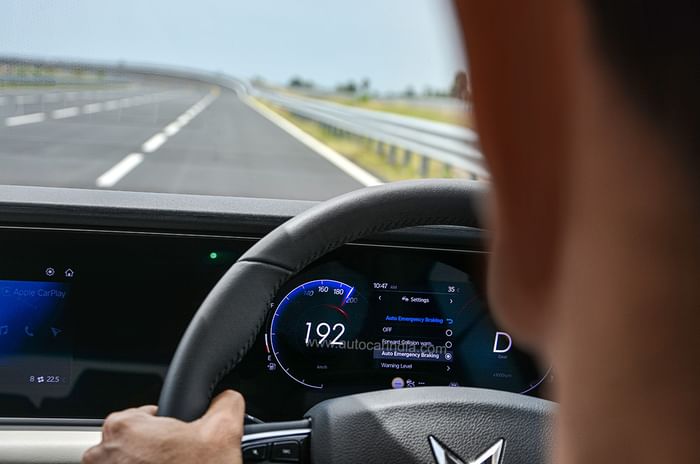
However, it has to be said that both, auto and manual boxes aren’t what you’d call quick shifters: the manual isn’t super slick, and the auto has a discernible pause between shifts. That being said, this is only when you are flat out rushing it, while in everyday driving and even slightly spirited runs, it does just fine. What's also nice is that despite the high torque, both manual boxes have a light clutch, though the engagement could have been more progressive.
The auto box’s shift logic is also very well sorted. While we had limited time in real-world traffic, it never felt like it was in the wrong gear and at no point did I try and reach for the (missing) paddles for manual intervention. Refinement within the cabin is expectedly vibration free.
The gearing on the petrol-manual is a bit on the tall side, which gives it a nice long-leggedness that is great for cruising. Overall refinement of the petrol is just superb. For those wanting a smooth and effortless drive, you just can’t have it better than the XUV700 for the money.
The 2.2-litre diesel too is superbly refined, and while the engine note is audible as you pile on the revs, it isn’t really harsh or intrusive. Performance is also very impressive, and unlike the petrol that has no drive modes, the diesel has three – cheekily called Zip, Zap, Zoom. In Zip, power is reduced to 155hp and so this mode is meant for relaxed driving, whilst Zap and Zoom get the full 185hp. The only difference between the two modes is a sharper throttle response in Zoom, which extracts the maximum performance from the engine.
Performance is something the diesel XUV700 has no shortage of. There is a bit of a turbo lag, but this is only in relation to the strong performance that comes in at the 1,400rpm mark, which from then on stays strong and linear till about 4,000rpm. On the whole, its performance is clearly a strong point, and we registered a 0-100kph time of 10.34sec in the auto.
Drivability is very good too, there’s ample torque, making the engine very tractable, and the manual can easily pick up pace cleanly from as low as 1,200rpm in sixth. Work the 'box properly though and you will be rewarded with a spirited drive. The gear ratios are well spaced but seem a tad shorter geared, more for performance rather than efficiency, which should work out just fine as the diesel engine is inherently efficient.
Fuel efficiency figures haven’t been disclosed yet, but Mahindra says the XUV700 should be the most fuel-efficient car in its class.
Mahindra XUV700: ride and handling
The biggest area of improvement over the XUV500 is the dynamics. Gone is the jittery ride, the torque steer and the sloppy handling, which is replaced by a sure-footed composure and easy and predictable handling. The key to the XUV700’s transformed ride and handling is the suspension system.
Like the Jeep Compass, the XUV700’s front and rear independent setup use frequency selective dampers where two parallel oil flow paths are tuned to deliver a different and optimal damping rate for both, high and low frequency ranges. The rear linkages also include an additional control blade link to better define individual wheel movement and it all works well.

Road grip is good and cornering is quite sharp. The electric power steering also has just the right amount of feel; it’s light enough at low speeds but feels secure and stable at higher speeds. Out on the highway, you can also hold your speed over slightly broken surfaces with a good degree of confidence. Speaking of confidence, on the high-speed track, the XUV700 felt quite composed at high triple-digit speeds.
If anything, the XUV700, which still has a high centre of gravity, feels a bit top heavy and rolls a little when pushed hard. Also, the ride is not quite as settled as some of its rivals.
Mahindra XUV700: safety
Lately, Mahindra has put a lot of effort into safety and its XUV300, which has a 5-star GNCAP rating, can lay claim to being India’s safest car. While the XUV700’s crash rating isn’t out as yet, expect a very good performance here too. More importantly, though, the company has also invested a lot into active safety, and in what is unique in the segment, the XUV700 has a very comprehensive ADAS package.
The system uses both, camera and radar which when linked to Forward Collision Warning (FCW) and Autonomous Emergency Brakes (AEB) work very well; we simulated this on the test track and came away quite impressed. Also impressive is the Adaptive Cruise Control (ACC), which enables you to safely follow a car ahead, and the Smart Pilot Assist or traffic assist (AT only), which can manage stop-start crawls too. The tuning is spot on and changes in pace are quite smooth and natural. The only aspect of the ADAS system that needs fine-tuning is the Lane Keep Assist, which works well in corners but does not keep the car centred on straights. That aside though, the ADAS package is very commendable and revolutionary in this segment.
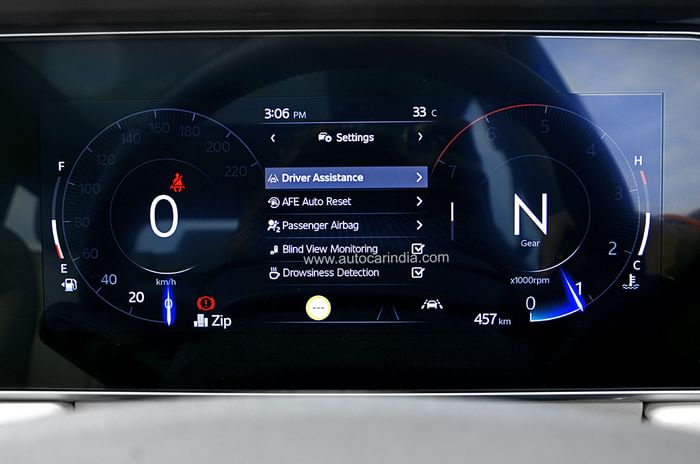
There’s also a novel personalised safety alert that can be programmed with the voice of a loved one to remind you to slow down when you come to a set speed! How cool is that?
Other active safety features are driver drowsiness detection, auto high beam assist and booster headlights that increase illumination above 80kph; Mahindra says the lumens and spread do not exceed the permissible limit. ABS and ESP round off the active safety bits, while seven airbags, including a knee airbag, bring up the passive features.
Mahindra XUV700: verdict
It’s impossible to ignore prices for the XUV700 and while Mahindra has only released details for four of the lower trim, 5-seater manual cars, the pricing has rocked the market. At Rs 11.99 lakh for the MX petrol-manual, the entry XUV700 is priced like a sub-four-metre SUV, and at Rs 14.99 the mid-level AX petrol-manual is still brilliant value.
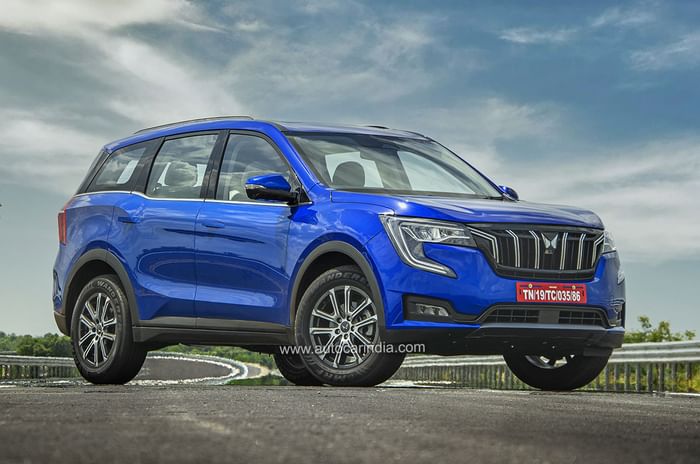
Mahindra will also have on offer pretty much every powertrain combination and plenty more variants too, so it’s clear then that the company is throwing everything it can into the XUV700. This is the model with which Mahindra is plotting its fightback, after the specialist SUV maker lost ground to Tata Motors, Hyundai and even new entrants like Kia. In that sense, the XUV700 comes in at the right time.
Variants and prices aside, the XUV700 still comes across as a very compelling package. Yes, there are some cheap bits inside, it does miss some features like cooled seats and the infotainment system could have been more logically designed. However, these niggles are insignificant in the light of its strengths. The brilliant engines just blow the competition away, it’s easy to drive and live with, and if that’s not enough to wow, the incredible features list and tech certainly will. The XUV700 is best-in-class in so many areas, and when you factor in the knockout prices, it’s clear that Mahindra isn’t just here to play, it’s come for the kill. The competition had better run for cover.




































